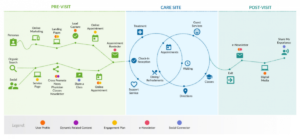Why Healthcare Needs to Invest in Consumer JourneysFor healthcare organizations to improve their consumer experience, they need to emphatically understand their experience from start to finish. A proven way to do that is by mapping the consumer journey.As healthcare requires sensitivity, it’s critical to know how and when consumers need to engage with you, to anticipate what they need, and guide them along the most relevant path.With the growth of expanded care delivery options, such as urgent care facilities, patients are increasingly unaffiliated with the organizations providing care. New research from two recent studies shows that 30% of patients do not have primary care physicians and instead seek care from system resources without a “home” doctor. * Download PDF StudyThese “unattached” patients are just as worthy of your attention as new patients. Moreover, a healthcare system whose business model is dependent on downstream revenue from PCPs is threatened by the movement of patients towards these new models of care and the economic incentive of insurers who design plans for younger consumers. Our research suggests up to 40% of healthcare consumers between 25 and 35 opt out of selecting a primary care physician. And once patients discover that those alternatives can satisfy their needs, they don’t come back.EVERY JOURNEY MATTERSThe opportunity is clear – new and existing patients need to be nurtured and supported on their journey. But why are so few hospitals putting the necessary effort into user journey investments?– It’s difficult. Building a relationship with your audience through every stage of the customer journey requires a clear strategy, operational alignment, and technical expertise.– Programs need to be run at scale. There’s not a single consumer in healthcare. For example, a woman 35 to 50 may be the primary healthcare decision maker for herself, as well as her husband, children, and elderly parents. This single consumer’s need crosses numerous service lines, appointments, and locations.– Journeys require a change in mindset. As a marketer, it’s no longer paramount to control the message. Consumers indicate the experience they need by their engagement – and they increasingly expect every digital interaction to be relevant and personalized for those indicated needs.Healthcare organizations often contain more knowledge about their consumer than they display in practice. It often takes an external partner to identify and catalyze that knowledge into a clear, cohesive strategy. Study client organizations have found that creating a Journey Map is a concise, effective way to create and visualize that strategy: Many products today hand off users between campaigns, channels, and sites, which unintentionally throws away their intent and forces them to start over or disengage. Study Journey safely can connect the experience across channels without compromising a user’s privacy.Journey Maps are not meant to be printed out and hung on a wall to gather dust. Rather, they’re meant to be actualized, measured, and improved upon. For healthcare systems, there’s a credible business need to craft, deliver, and refine digital consumer experiences.Journey Maps can embody the strategy throughout the planning process and become the scorecard for future marketing success. If you’re ready to take that next step, there’s nothing that can hold you back.Source: Co Study: Medtouch, Acquia
Many products today hand off users between campaigns, channels, and sites, which unintentionally throws away their intent and forces them to start over or disengage. Study Journey safely can connect the experience across channels without compromising a user’s privacy.Journey Maps are not meant to be printed out and hung on a wall to gather dust. Rather, they’re meant to be actualized, measured, and improved upon. For healthcare systems, there’s a credible business need to craft, deliver, and refine digital consumer experiences.Journey Maps can embody the strategy throughout the planning process and become the scorecard for future marketing success. If you’re ready to take that next step, there’s nothing that can hold you back.Source: Co Study: Medtouch, Acquia
Unlock your growth potential
Talk with one of experts to explore how Asure can help you reduce administrative burdens and focus on growth.
